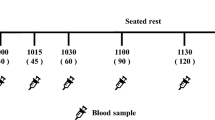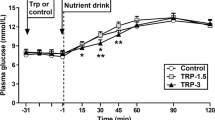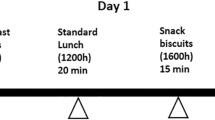Abstract
Objective: Dietary supplementation with guar gum or fructose has been reported to reduce the postprandial glycemic response to an oral glucose challenge. As a result of the poor palatability of most foods containing guar gum, a novel low-viscosity beverage with guar gum was developed that becomes viscous in vivo through an enzymatic induction. The primary study objective was to determine the effect of an amylase-induced viscosity (I-V) product, with or without supplemental fructose, on the postprandial glycemic response to a high glycemic index test meal in healthy nondiabetic subjects.
Design: The study was a four-treatment, placebo-controlled, double-blind, randomized block protocol.
Setting: The study was performed at Glycaemic Index Testing, Inc., Toronto, Ontario, Canada.
Subjects: A total of 30 healthy nondiabetic volunteers (13 male, 17 female, mean±s.e.m. age of 51±3 y and body mass index of 24.2±0.4 kg/m2) participated in the study.
Interventions: In the morning after an overnight fast, subjects participated in four 3-h meal glucose tolerance tests on separate occasions. The test meals contained 50 g of available carbohydrate from maltodextrin and white bread (control) or the same meal with either 5 g of guar gum (3.6 g galactomannan), 5 g of fructose, or 5 g of guar gum +5 g of fructose.
Results: Treatments containing guar gum had a reduced (P<0.01) baseline-adjusted peak glucose response and incremental area under the glucose curve. In contrast to previous studies, fructose increased (P<0.05) the baseline-adjusted peak glucose concentration.
Conclusions: Guar gum incorporated into an amylase I-V product provided a means to stabilize blood glucose levels by reducing the early phase excursion and then by appropriately maintaining the later phase excursion in healthy nondiabetic humans.
This is a preview of subscription content, access via your institution
Access options
Subscribe to this journal
Receive 12 print issues and online access
$259.00 per year
only $21.58 per issue
Buy this article
- Purchase on Springer Link
- Instant access to full article PDF
Prices may be subject to local taxes which are calculated during checkout

Similar content being viewed by others
References
American Diabetes Association (1997): Report of the expert committee on the diagnosis and classification of diabetes mellitus. Diabetes Care 20, 1183–1197.
Anderson JW, Gustafson NJ, Bryant CA & Tietyen-Clark J (1987): Dietary fiber and diabetes: a comprehensive review and practical application. J. Am. Dietetic Assoc. 87, 1189–1197.
Aro A, Uusitupa M, Voutilainen E, Hersio K, Korhonen T & Siitonen O (1981): Improved diabetic control and hypocholesterolaemic effect induced by long-term dietary supplementation with guar gum in type 2 (insulin-independent) diabetes. Diabetologia 21, 29–33.
Brown H & Prescott R (1999): Applied Mixed Models in Medicine, Chichester, England: John Wiley & Sons Ltd.
Carroll DG, Dykes V & Hodgson W (1981): Guar gum is not a panacea in diabetes management. NZ Med. J. 93, 292–294.
Cohen M, Leong VW, Salmon E & Martin FIR (1980): Role of guar and dietary fibre in the management of diabetes mellitus. Med. J. Austr. 1, 59–61.
Crapo PA, Kolterman OG & Olefsky JM (1980): Effects of oral fructose in normal, diabetic, and impaired glucose tolerance subjects. Diabetes Care 3, 575–582.
Crosby G (2000): A dramatic effect of maltodextrin on the viscosity of aqueous dispersions of konjac flour. In Abstracts of the First International Conference on Dietary Fibre, Dublin, Ireland.
Ebeling P, Yki-Jarvinen H, Aro A, Helve E, Sinisalo M & Koivisto VA (1988): Glucose and lipid metabolism and insulin sensitivity in type 1 diabetes: the effect of guar gum. Am. J. Clin. Nutr. 48, 98–103.
Ellis PR, Dawoud FM & Morris ER (1991): Blood glucose, plasma insulin and sensory responses to guar-containing wheat breads: effects of molecular weight and particle size of guar gum. Br. J. Nutr. 66, 363–379.
Ellis PR, Morris ER & Low AG (1986): Guar gum: the importance of reporting data on its physico-chemical properties. Diabetic Med. 3, 490–491.
Flickinger EA, Wolf BW, Garleb KA, Chow JM, Leyer GJ, Johns PW & Fahey Jr GC (2000): Glucose-based oligosaccharides exhibit different in vitro fermentation patterns and affect in vivo apparent nutrient digestibility and microbial populations in dogs. J. Nutr. 130, 1267–1273.
Fuessl S, Adrian TE, Bacarese-Hamilton AJ & Bloom SR (1986): Guar in NIDD: effect of different modes of administration on plasma glucose and insulin responses to a starch meal. Pract. Diabetes 3, 258–260.
Fujisawa T, Riby JE & Kretchmer N (1991): Intestinal absorption of fructose in the rat. Gastroenterology 101, 360–367.
Gatti E, Catenazzo G, Camisasca E, Torri A, Denegri E & Sirtori CR (1984): Effects of guar-enriched pasta in the treatment of diabetes and hyperlipidemia. Ann. Nutr. Metab. 28, 1–10.
Groop P-H, Aro A, Stenman S & Groop L (1993): Long-term effects of guar gum in subjects with non-insulin-dependent diabetes. Am. J. Clin. Nutr. 58, 513–518.
Harris JA & Benedict FG (1919): A Biometric Study of Basal Metabolism in Man, Publication 279, p 227, Washington, DC: Carnegie Institute.
Heacock PM, Hertzler SR & Wolf BW (2002): Fructose prefeeding reduces the glycemic response to a high-glycemic index, starchy food in humans. J. Nutr. 132, 2601–2604.
Heijnen MLA, van Amelsvoort JMM & Weststrate JA (1995): Interaction between physical structure and amylose:amylopectin ratio of foods on postprandial glucose and insulin responses in healthy subjects. Eur. J. Clin. Nutr. 49, 446–457.
Hertzler SR, Huynh B-CL & Savaiano DA (1996): How much lactose is low lactose? J. Am. Diet. Assoc. 96, 243–246.
Hoekstra JH & van den Aker JHL (1996): Facilitating effect of amino acids on fructose and sorbitol absorption in children. J. Pediatr. Gastroenterol. Nutr. 23, 118–124.
Holum JR (1982): Fundamentals of General, Organic, and Biological Chemistry. 2nd Edition, p 111, New York: Wiley and Sons.
Jarjis HA, Blackburn NA, Redfern JS & Read NW (1984): The effect of ispaghula (Fybogel and Metamucil) and guar gum on glucose tolerance in man. Br. J. Nutr. 51, 371–378.
Jenkins DJA, Wolever TMS, Leeds AR, Gassull MA, Haisman P, Dilawari J, Goff DV, Metz GL & Alberti KGMM (1978): Dietary fibres, fibre analogues, and glucose tolerance: importance of viscosity. Br. Med. J. 1, 1392–1394.
Jenkins DJA, Wolever TMS, Taylor RH, Barker H, Fielden H, Baldwin JM, Bowling AC, Newman HC, Jenkins AL & Goff DV (1981): Glycemic index of foods: a physiological basis for carbohydrate exchange. Am. J. Clin. Nutr. 34, 362–366.
Kirsten R, Heintz B, Nelson K, Oremek G & Speck U (1992): Influence of two guar preparations on glycosylated hemoglobin, total cholesterol and triglycerides in patients with diabetes mellitus. Int. J. Clin. Parmacol. Ther. Toxicol. 30, 582–586.
Moore MC, Cherrington AD, Mann SL & Davis SN (2000): Acute fructose administration decreases the glycemic response to an oral glucose tolerance test in normal adults. J. Clin. Endocrinol. Metab. 85, 4515–4519.
Moore MC, Mann SL, Davis SN & Cherrington AD (2001): Acute fructose administration improves oral glucose tolerance in adults with type 2 diabetes. Diabetes Care 24, 1882–1887.
Philipson EH, Rossi KQ, Isaac RM & Kalhan SC (1992): Glucose, insulin, gastric inhibitory polypeptide, and pancreatic polypeptide responses to polycose during pregnancy. Obstet. Gynecol. 79, 592–596.
Read NW, Al-Janabi MN, Bates TE, Holgate AM, Cann PA, Kinsman RI, McFarlane A & Brown C (1985): Interpretation of the breath hydrogen profile obtained after ingesting a solid meal containing unabsorbable carbohydrate. Gut 26, 834–842.
Seidner DL, Roberts IM & Smith MS (1990): Esophageal obstruction after ingestion of a fiber-containing diet pill. Gastroenterology 99, 1820–1822.
Shi X, Schedl HP, Summers RM, Lambert GP, Chang R-T, Xia T & Gisolfi CV (1997): Fructose transport mechanisms in humans. Gastroenterology 113, 1171–1179.
Strocchi A, Corazza G, Ellis CJ, Gasbarrini G & Levitt MD (1993): Detection of malabsorption of low doses of carbohydrate: accuracy of various breath H2 criteria. Gastroenterology 105, 1404–1410.
Todd PA, Benfield P & Goa KL (1990): Guar gum: a review of its pharmacological properties, and use as a dietary adjunct in hypercholesterolaemia. Drugs 39, 917–928.
Tredger J & Ransley J (1978): Guar gum—its acceptability to diabetic patients when incorporated into baked food products. J. Hum. Nutr. 32, 427–432.
Tuomilehto J, Voutilainen E, Huttunen J, Vinni S & Homan K (1980): Effect of guar gum on body weight and serum lipids in hypercholesterolemic females. Acta Med. Scand. 208, 45–48.
Uusitupa M, Siitonen O, Savolainen K, Silvasti M, Penttila I & Parviainen M (1989): Metabolic and nutritional effects of long-term use of guar gum in the treatment of noninsulin-dependent diabetes of poor metabolic control. Am. J. Clin. Nutr. 49, 345–351.
Williams DRR, James WPT & Evans IE (1980): Dietary fibre supplementation of a ‘normal’ breakfast administered to diabetics. Diabetologia 18, 379–383.
Wilson JA, Scott MM & Gray RS (1989): A comparison of metformin versus guar in combination with sulphonylureas in the treatment of non insulin dependent diabetes. Horm. Metab. Res. 21, 317–319.
Wolever TMS & Bolognesi C (1996): Source and amount of carbohydrate affect postprandial glucose and insulin in normal subjects. J. Nutr. 126, 2798–2806.
Wolever TMS & Jenkins DJA (1993): Effect of dietary fiber and foods on carbohydrate metabolism. In CRC Handbook of Dietary Fiber in Human Nutrition, ed. GA Spiller, pp 111–152. Boca Raton, FL: CRC Press, Inc.
Wolever TMS, Jenkins DJA, Jenkins AL & Josse RG (1991): The glycemic index: methodology and clinical implications. Am. J. Clin. Nutr. 54, 846–854.
Wolever TMS, Jenkins DJA, Nineham R & Alberti KGMM (1979): Guar gum and reduction of post-prandial glycaemia: effect of incorporation into solid food, liquid food, and both. Br. J. Nutr. 41, 505–510.
Wolever TMS, Taylor R & Goff DV (1978): Guar: viscosity and efficacy. Lancet 2, 1381.
Wolf BW, Humphrey PM, Hadley CW, Maharry KS, Garleb KA & Firkins JL (2002): Supplemental fructose attenuates postprandial glycemia in Zucker fatty fa/fa rats. J. Nutr. 132, 1219–1223.
Author information
Authors and Affiliations
Contributions
Guarantor: BW Wolf.
Contributors: BWW was the person mainly responsible for all stages of the study, including the study design, discussion and interpretation of results and writing of the paper. TMSW, CB and RR were in charge of the medical management of subjects, administration of the meal tolerance test, sample collection and preparation, and glucose analysis. CSL carried out the development of the test products. KAG and JLF participated in the discussion and interpretation of the results. KSM completed the statistical analyses. SRH carried out the determination of breath hydrogen and methane.
Corresponding author
Rights and permissions
About this article
Cite this article
Wolf, B., Wolever, T., Lai, C. et al. Effects of a beverage containing an enzymatically induced-viscosity dietary fiber, with or without fructose, on the postprandial glycemic response to a high glycemic index food in humans. Eur J Clin Nutr 57, 1120–1127 (2003). https://doi.org/10.1038/sj.ejcn.1601652
Received:
Revised:
Accepted:
Published:
Issue Date:
DOI: https://doi.org/10.1038/sj.ejcn.1601652
Keywords
This article is cited by
-
Efficacy of different fibres and flour mixes in South-Asian flatbreads for reducing post-prandial glucose responses in healthy adults
European Journal of Nutrition (2017)
-
Fiber facts: Benefits and recommendations for individuals with type 2 diabetes
Current Diabetes Reports (2009)



